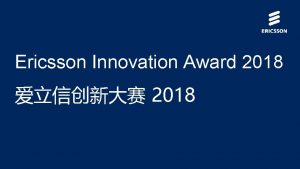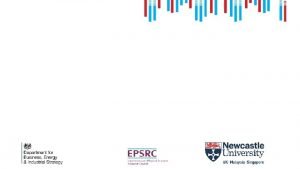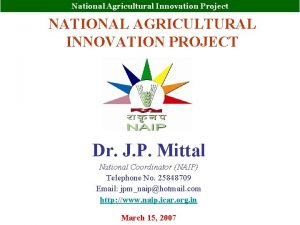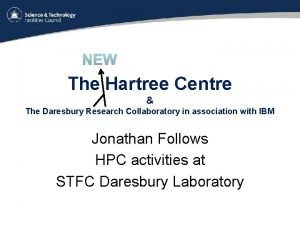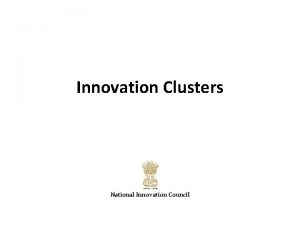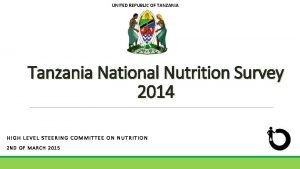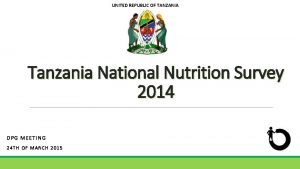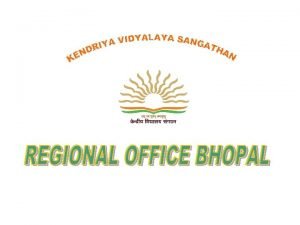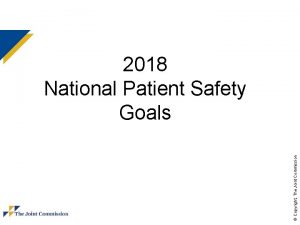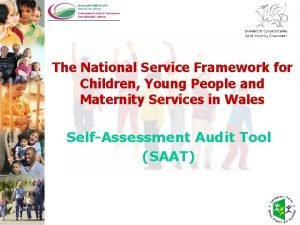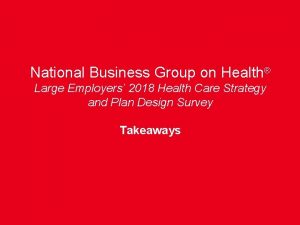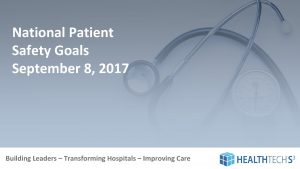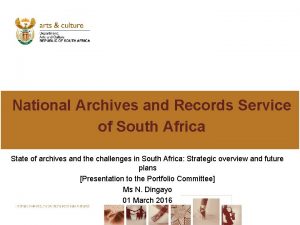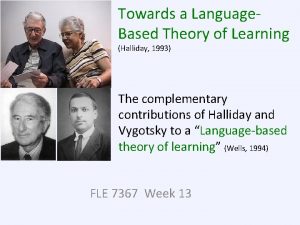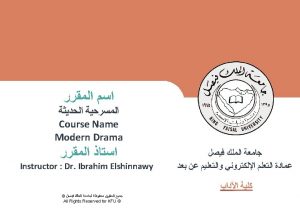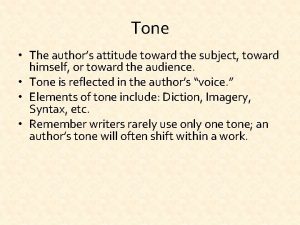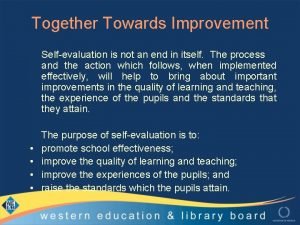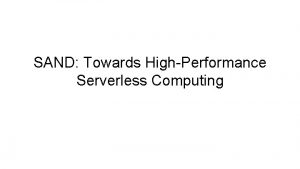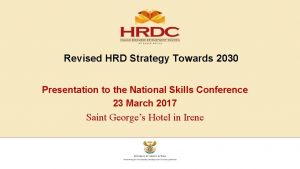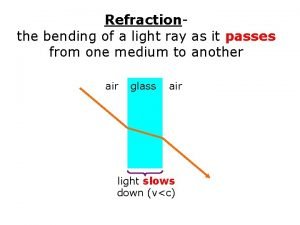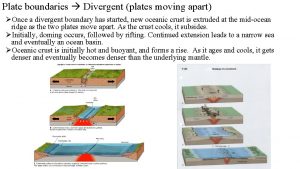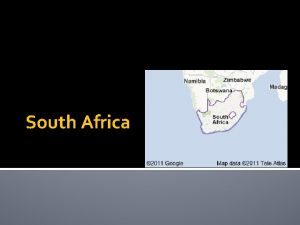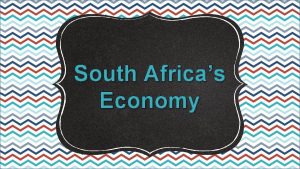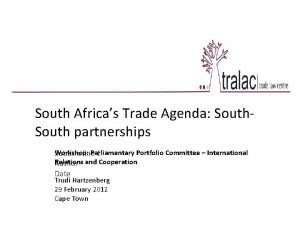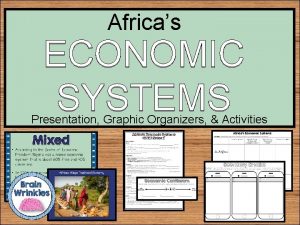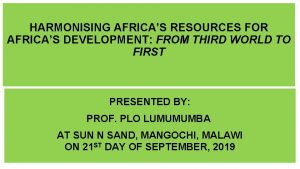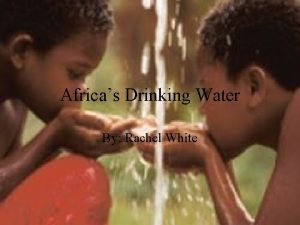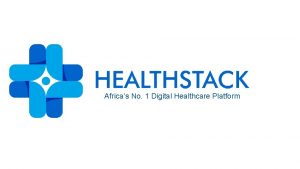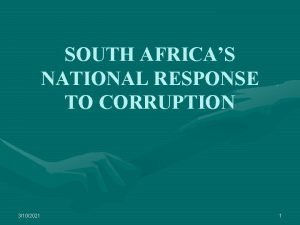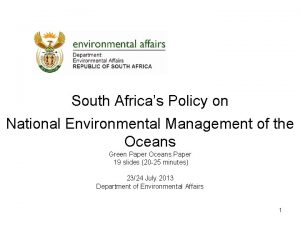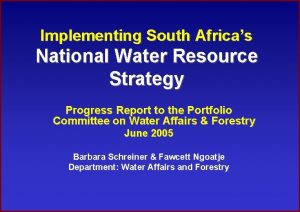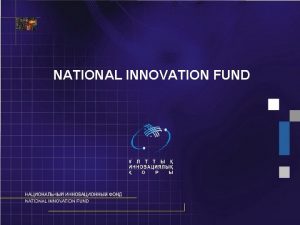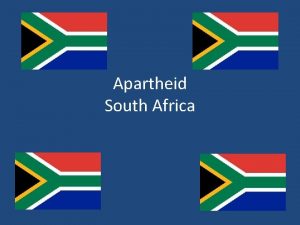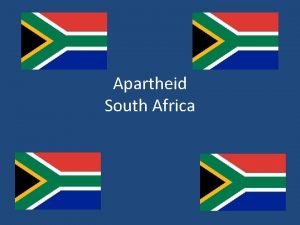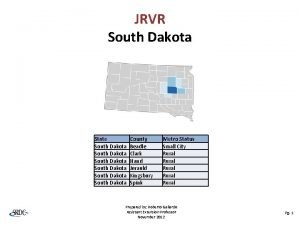Towards 2018 South Africas 10 Year National Innovation






























- Slides: 30

Towards 2018: South Africa’s 10 -Year National Innovation Plan Presented by: Dr Phil Mjwara, Director General, Department of Science & Technology Tuesday, 20 Nov 2007

Contents 1. Economic Transformation towards a Knowledge Economy 2. SA’s “Grand Challenges” 3. Innovation as a National Imperative i. Innovation Instruments ii. Human Capital Development iii. S&T Across Government 4. Conclusion

Policy landscape NSI SWOT Benchmarked New public S&T missions §Biotechnology §ICT §Advanced manufacturing §Astronomy Developing the NSI Creation of DST R&D Strategy S&T missions 2002 10 Yr Innovation Plan Knowledge-based economy, linked to NIPF & other initiatives §Grand challenges §Human capital development S&T White Paper 1996 OECD Review of SA NSI 2004 2007

Economic Transformation Degree of technological maturity and market saturation Stage of technology development 1 = Early phase 2 = Growth phase 3 = Efficiency phase Information age 3 3 Age of steam 2 2 1 1829 1850 s 1971 2007 Time Bio-economy

Towards a Knowledge Economy KNOWLEDGE-BASED ECONOMY RESOURCE-BASED ECONOMY

The Knowledge Economy The Four Pillars of the Knowledge Economy

Economic & Scientific Wealth Source: DA King, Nature 430 (2004) 311 (15 July 2004)

Towards a Knowledge Economy • • Economic growth is driven by Innovation Knowledge is the basic form of capital for Innovation – – – Knowledge generation, accumulation and exploitation Key driver for Innovation is “high-end” human capital: Ph. D as the key foundation for achieving the objectives of the National System of Innovation (NSI)

Principles of the 10 Year Innovation Plan Principles informing 10 Year Innovation Plan: • Articulates an innovation path to contribute fundamentally towards the transformation of the economy to a knowledge economy; • Informed by ‘triage’ in decision-making i. t. o: • Focus on SA’s areas of competence; • Global Objectives; • Societal transformation; and • Based on premise that government’s growth targets require a significant investment in innovation

“Grand Challenges” 1. Farmer to Pharma value chain to strengthen the bio-economy; 2. Space S&T; 3. Energy security; 4. Global-change science (climate change); and 5. Human and social dynamics.

Knowledge Generation Cross- cutting enablers Grand challenges Enablers Technology development and innovation Farmer to pharma Space science Energy Global change Human & social dynamics Human capital - South African research chairs initiative, professional development programme, etc. Knowledge infrastructure – Science councils, state-owned enterprises, global projects

Knowledge Generation • Early-stage research (for example nanotechnology where the innovation is uncertain and projected well into the future); • Science missions (exploiting the ‘living laboratories’ of local resources and geographic advantage to generate meaningful scientific research outputs/knowledge products);

Knowledge Generation and exploitation • Technology missions (for example advanced manufacturing where innovation is possible in the near future); • Conventional sectors (institutional mandates for growing the research base such that the entire sector and the economy constantly benefits, for example agriculture or health).


Basic Applied Tech Develop Transfer & Proliferation COEs Competency Centres DOE/NRF NRF/DST DST/TIA PBF/DTI • Research Chairs • Innovation Fund • SEDA • PGP & HCD instruments • BRICs • Khula • RISA instruments • SPII & PII • IDC Publications/new knowledge Patents/new knowledge products

Basic Applied Tech Develop Transfer & Proliferation NRF Specialist Research Funds IDC TIA Venture Capital International Research Funds SEDA PBF Publications/new knowledge Patents/new knowledge products

IP Support TI Fund Venture Capital Access Enterprise Development Competency Centres BRICS Hydrogen Economy AMI AMTS

Innovation as a National Competence 1. 2. 3. 4. 5. Technology Innovation Agency (TIA) Intellectual Property Rights Bill (IPR) Centres of Competence Public Benefit Foundation (PBF) Regional Innovation Systems • Technology Parks

Human Capital Development Increase the number of knowledge workers: Researchers Increase the productivity of researchers Address inequalities: Race, gender, regional & institutional distribution Introducing appropriate Innovation Instruments in the National System of Innovation

Knowledge-based Economies

Strategic Positioning IN WHICH LEAGUE DO WE WANT TO PLAY? Country Factor China? ? X 0. 34 India? ? X 0. 44 Brazil X 1. 9 Taiwan X 2. 3 Japan X 4. 9 USA X 6. 1 South Korea X 6. 8 UK X 8. 2 Australia X 9. 7 South Africa In 2026 (20 yrs) A 5 x increase to present situation South Africa In 2026 (20 yrs) A 10 x increase to future situation

Points of leverage from current situation 1. < 10% proceed from a basic degree to pursue honours 2. 2. Only 19% proceed from Masters to Doctoral studies 1 Existing National SET pipeline (2005) 26, 000 HG Maths and Science ~ per yr 15, 991 SET graduation rates ~per yr 3, 200 Hons grad rates~ per yr 2 2, 900 Masters ~ per yr (incl. coursework) 561 Ph. D’s ~ per yr

Research Outputs: Scientific Journals

Research Outputs: International Comparison

Research Outputs: Patents

S&T Across Govt • • Inter-Departmental S&T initiatives (Technology Managers Forum); Infrastructure investment in line with ASGISA (i. e. rail, road, air, energy, etc. ); Public procurement innovation (support local innovations incl. SMME’s and techno startups); and Monitoring S&T in SA (annual reviews, surveys and patent statistics).

OECD Review: Key Findings • Human Capital for SET is sub-optimal. • A long term planning Framework is needed. • The governance framework needs more vertical and horizontal integration. • There is an innovation chasm with an insufficient number of research products directly influencing the real economy. • Science, Technology and Innovation for the 2 nd economy should be more pronounced and visible.

Conclusion… • Application of knowledge to generate new products and services; – • • Five “grand challenges” as a mechanism to create focus and developing a research agenda with specific national outcomes; Ensure innovation as a national competence is strengthened by appropriate mechanisms (i. e. TIA; Centres of Competence); Enhance country’s ability to generate knowledge including early stage research areas;

Conclusion (cont. ) • • Infrastructure Internationalisation of our Research Enterprise

KE A LEBOGA #(121340)
 Whats africas largest lake
Whats africas largest lake Innovation for the sake of innovation
Innovation for the sake of innovation Incremental innovation vs disruptive innovation
Incremental innovation vs disruptive innovation Ericsson innovation awards 2018
Ericsson innovation awards 2018 Que letra continua m v t m j
Que letra continua m v t m j Old south vs new south streetcar named desire
Old south vs new south streetcar named desire National innovation council
National innovation council National innovation centre for data
National innovation centre for data National agricultural innovation project
National agricultural innovation project Hartree national centre for digital innovation
Hartree national centre for digital innovation National innovation council india
National innovation council india Leavers acrostic poem
Leavers acrostic poem Tanzania national nutrition survey 2018
Tanzania national nutrition survey 2018 Tanzania national nutrition survey 2020
Tanzania national nutrition survey 2020 Kvs national sports meet 2018-19
Kvs national sports meet 2018-19 Npsg 2018
Npsg 2018 National service framework for children/ 2018
National service framework for children/ 2018 National business group on health conference 2018
National business group on health conference 2018 2018 national patient safety goals
2018 national patient safety goals National geographic photo contest 2018
National geographic photo contest 2018 Core standards
Core standards South african national archives
South african national archives National geographic photo of the year
National geographic photo of the year Halliday 1993
Halliday 1993 What is torvald's attitude toward borrowing money?
What is torvald's attitude toward borrowing money? It is the authors attitude towards the subject
It is the authors attitude towards the subject Together towards improvement
Together towards improvement Sand: towards high-performance serverless computing
Sand: towards high-performance serverless computing E hrdsa
E hrdsa Light bending towards the normal
Light bending towards the normal Divergent boundary
Divergent boundary



